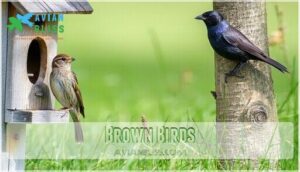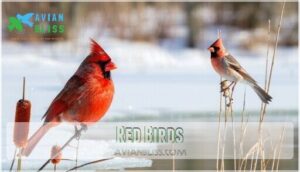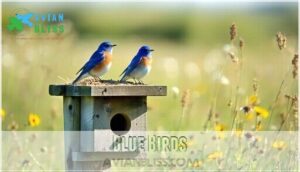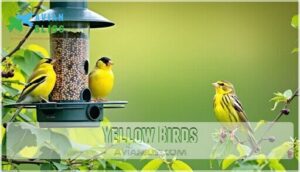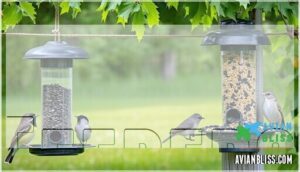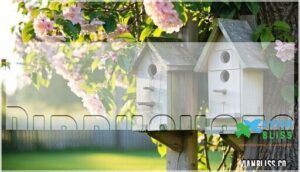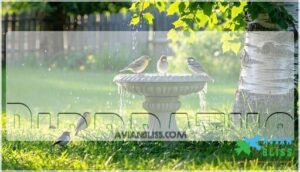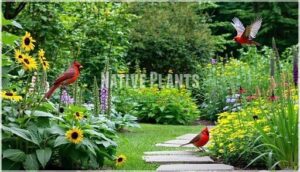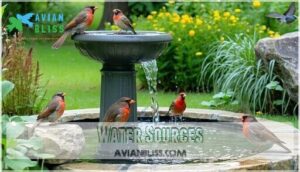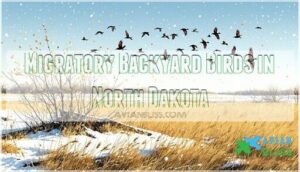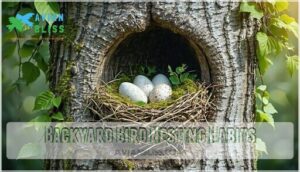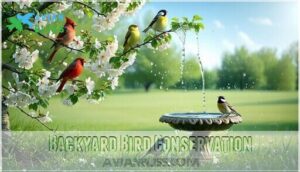This site is supported by our readers. We may earn a commission, at no cost to you, if you purchase through links.
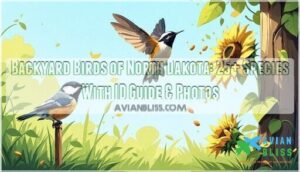
These feathered neighbors include year-round residents like White-breasted Nuthatches and seasonal visitors such as Ruby-throated Hummingbirds.
North Dakota’s prairie landscape attracts both common species like House Sparrows and exciting migrants following the Central Flyway.
Your backyard becomes a birding hotspot with simple black oil sunflower seed feeders and fresh water sources.
The state’s unique position creates a perfect storm for bird diversity, where grassland species meet woodland dwellers, making it an ideal place for dedicated bird enthusiasts with native plants.
Smart feeder placement reveals secrets that transform casual observers into enthusiasts.
Table Of Contents
- Key Takeaways
- Common Backyard Birds in North Dakota
- Identifying Backyard Birds by Color
- Attracting Birds to Your Backyard
- Migratory Backyard Birds in North Dakota
- Backyard Bird Feeding Tips
- Backyard Bird Nesting Habits
- Backyard Bird Behavior
- Backyard Bird Conservation
- Backyard Bird Photography Tips
- Frequently Asked Questions (FAQs)
- How can I identify the birds in my backyard?
- What kind of birds does North Dakota have?
- How do I find out what birds are in my area?
- What is the state bird for North Dakota?
- How do I identify a bird in my backyard?
- How do I know what birds are in my area?
- Are there cuckoo birds in North Dakota?
- What is the state bird of North Dakota?
- What are the best bird baths for backyard birds?
- How can I prevent window strikes by backyard birds?
- Conclusion
Key Takeaways
- You’ll easily attract over 25 North Dakota bird species by setting up feeders with black oil sunflower seeds, providing fresh water sources, and planting native species that offer natural food and shelter year-round.
- You can identify backyard birds by sorting them into color groups – look for red cardinals and red-winged blackbirds, yellow goldfinches and warblers, blue eastern and mountain bluebirds, and brown house sparrows and nuthatches.
- You’ll see different birds throughout the seasons, with spring arrivals like robins and red-winged blackbirds, summer residents during breeding season, fall departures of most migrants, and hardy year-round residents like chickadees and nuthatches that brave North Dakota winters.
- You can help bird conservation by preventing window collisions with decals or screens, keeping cats indoors, avoiding pesticides in your yard, and participating in citizen science projects like eBird to track local bird populations.
Common Backyard Birds in North Dakota
You’ll spot five main bird species in most North Dakota backyards, and they’re easier to identify than you might think.
The American Robin leads the pack with its bright orange chest, while the chatty Black-capped Chickadee brings year-round entertainment to your feeders with its acrobatic antics.
Black-capped Chickadee
Meet North Dakota’s most acrobatic backyard bird – the Black-capped Chickadee. These intelligent creatures hang upside-down while foraging, showcasing remarkable chickadee adaptations.
These fearless acrobats turn your backyard into a year-round circus with their upside-down antics and cheeky personalities.
Their distinctive chick-a-dee-dee-dee chickadee sounds echo through winter woods.
The chickadee diet includes insects, seeds, and suet from feeders. These fearless North Dakota birds thrive in wooded chickadee habitat, bringing year-round entertainment to your backyard birding experience.
American Robin
American Robins are North Dakota’s most common backyard birds, appearing on 39% of bird watching lists.
You’ll recognize their rusty-red breast and cheerful song announcing spring’s return.
These robin habitat lovers prefer lawns for hunting earthworms and build cup-shaped nests in trees.
Their robin diet includes insects, berries, and worms, making robin identification easy during robin migration seasons across north dakota birds communities.
House Sparrow
House Sparrows dominate North Dakota backyard birds with their scrappy personalities and year-round presence.
These invasive species originally from Europe now compete fiercely for nest boxes with native birds.
- Chunky brown bodies with distinctive black bibs on males
- Aggressive behavior around feeders and nesting sites
- Adaptable House Sparrow diet includes seeds, insects, and table scraps
Their resilience makes bird identification easy for beginners. They’re known for opportunistic feeding strategies, which is a key aspect of their opportunistic feeding habits.
Mourning Dove
You’ll spot mourning doves by their soft cooing calls and graceful, pointed tails.
These gentle backyard birds prefer open areas and build flimsy nests in trees.
Their pale brown-pink bodies make bird identification easy among North Dakota backyard birds.
| Feature | Description | Notes |
|---|---|---|
| Dove Sounds | Soft "coo-coo-coo" calls | Peaceful morning songs |
| Dove Diet | Seeds, grains | Ground feeders |
| Dove Habitats | Open woodlands, suburbs | Year-round residents |
White-breasted Nuthatch
While mourning doves grace your yard with gentle coos, the White-breasted Nuthatch brings circus-level entertainment to North Dakota backyards.
This year-round resident masters unique climbing techniques that’ll make you do a double-take:
- Headfirst tree descents without missing a beat
- Sideways trunk navigation like a feathered gymnast
- Upside-down foraging moves
- Aggressive behavior toward larger feeder visitors
The presence of this bird can add a lot of excitement to your backyard, especially with its circus-level entertainment.
Identifying Backyard Birds by Color
You’ll find that sorting North Dakota’s backyard birds by color makes identification much easier than trying to remember every detail about wing bars and tail shapes.
When you spot a flash of red at your feeder or a yellow bird in your oak tree, you can quickly narrow down the possibilities and focus on the birds that actually match what you’re seeing.
Black Birds
Black birds dominate North Dakota backyards with their bold presence.
You’ll easily spot the Red-winged Blackbird flashing red shoulder patches, while Common Grackles strut across lawns with iridescent purple-blue plumage.
Brown-headed Cowbirds often tag along in mixed flocks.
Identifying blackbirds becomes simple once you notice their distinct sizes and grackle behavior – they’re confident ground foragers.
Brown Birds
Brown birds often puzzle backyard bird watchers, but sparrow identification gets easier with practice.
You’ll recognize House Sparrows by their chunky beaks and streaked backs.
Brown-headed Cowbirds strut around with glossy black bodies contrasting their chocolate heads.
Tree sparrows show rusty caps, while nuthatch varieties display blue-gray backs.
These North Dakota species prefer different habitat preferences – cowbirds follow livestock, sparrows love feeders.
Red Birds
Crimson-colored bird species bring vibrant splashes to North Dakota backyards throughout the year.
These striking backyard birds showcase stunning plumage variations that make identification easier for birdwatchers.
Three red bird species you’ll encounter:
- Northern Cardinal – Males display brilliant red feathers with distinctive black masks around their beaks
- Red-winged Blackbird – Features bright red shoulder patches contrasting against jet-black bodies
- Common Redpoll – Shows rosy-red caps and pink-tinged breasts during breeding season
Blue Birds
You’ll spot brilliant blue feathers flashing through your yard when Eastern Bluebirds and Mountain Bluebirds visit.
These backyard birds prefer open spaces with scattered perches. Eastern Bluebirds show rusty-orange breasts while Mountain Bluebirds display solid blue coloring.
Both species love nesting boxes and mealworms. Their habitat preference includes meadows and grasslands perfect for hunting insects.
Yellow Birds
The golden flash of yellow birds brings sunshine to North Dakota backyards year-round.
These bright beauties stand out against prairie skies, making bird identification guides come alive.
Identifying Yellows in your backyard:
- American Goldfinch – bright yellow males with black wings
- Yellow Warbler – sweet olive-yellow with rusty breast streaks
- Yellow-rumped Warbler – distinctive yellow patches on rump
- Evening Grosbeak – chunky yellow body with massive bill
- Common Yellowthroat – yellow throat with black mask
Diet Preferences vary widely among yellow species.
Attracting Goldfinches requires nyjer thistle feeders, while warblers prefer insects and suet.
Habitat Needs range from open fields to dense shrubs.
Nesting Yellows often choose protected spots in native plants, making your backyard a vibrant ecosystem.
Attracting Birds to Your Backyard
You can turn your yard into a bird magnet by offering the right food, water, and shelter that North Dakota’s feathered visitors need to thrive.
Think of it as opening a restaurant with room service – once word gets out among the local chickadees and robins, you’ll have regular customers showing up for breakfast every morning.
Feeders
Setting up bird feeders transforms your backyard into a bustling wildlife hub.
Choose the right feeder types and seed blends to attract North Dakota’s diverse backyard birds year-round.
- Tube feeders filled with black oil sunflower seeds draw chickadees and nuthatches
- Platform feeders with mixed bird seeds attract robins and sparrows
- Suet feeders provide essential winter feeding energy for woodpeckers
- Homemade feeders using recycled materials offer budget-friendly options
Consider exploring different tube feeder options for your yard.
Regular feeder maintenance keeps birds healthy and coming back.
Birdhouses
Through careful birdhouse placement and design, you’ll create irresistible nesting spots for North Dakota’s backyard birds.
Choose cedar or pine materials for durability. Size entrance holes correctly – 1.25 inches for chickadees, 1.5 inches for nuthatches.
Mount houses 5-15 feet high facing east or southeast. Cedar provides ideal weather-resistant construction.
Clean annually after nesting season ends. Proper bird habitats attract diverse species to your yard naturally.
Birdbaths
You’ll transform your yard into a bird magnet with the right birdbath setup. North Dakota’s backyard birds need reliable water sources for drinking and bathing year-round.
Follow these essential birdbath tips for attracting birds:
- Bath Placement – Position 3-10 feet from shrubs for quick escape routes
- Water Quality – Change water every 2-3 days to prevent algae buildup
- Bath Materials – Choose rough-textured surfaces for better bird grip
- Winter Baths – Add heated elements to prevent freezing during harsh months
During winter, consider using a reliable birdbath heater to keep the water from freezing.
- Bath Cleaning – Scrub weekly with diluted bleach solution, then rinse thoroughly
Native Plants
Native plants create a buffet that keeps backyard birds coming back for more.
These North Dakota natives offer year-round benefits that store-bought feeders simply can’t match. Native plants thrive in local soil conditions.
Plant Benefits for attracting birds:
- Seed Sources from sunflowers and coneflowers feed finches through winter
- Local Nurseries stock prairie grasses that provide nesting material
- Attracting Insects brings protein-rich meals for growing chicks
- Winter Interest from berry-producing shrubs sustains birds during harsh months
Water Sources
Fresh water draws backyard birds like a magnet draws metal.
Place bird baths in shaded spots near shrubs where North Dakota birds feel safe. Choose shallow bowls one to two inches deep so small songbirds can drink comfortably.
Clean your water sources every few days to prevent algae buildup.
During winter, heated bird baths keep water flowing when temperatures drop below freezing, which is crucial for the birds’ survival, especially with heated bird baths and in shaded spots.
Migratory Backyard Birds in North Dakota
You’ll notice North Dakota’s backyard birds follow predictable patterns throughout the year, with Red-winged Blackbirds arriving in early spring.
While others like Dark-eyed Juncos head south for warmer weather, understanding these migration schedules helps you know when to expect your feathered visitors.
This knowledge also informs you about which species stick around through those brutal prairie winters.
Spring Arrivals
March brings excitement as backyard birds return to North Dakota from their southern retreats. Canada Geese appear first when ice clears from lakes, followed by Horned Larks in February. Greater Prairie Chickens start their elaborate mating rituals on leks by mid-March.
- Arrival Dates: Horned Larks return in February, while most bird species arrive throughout March and April
- Mating Rituals: Sharp-tailed Grouse perform dawn courtship dances at traditional display grounds
- Territory Establishment: Males arrive first to claim prime nesting locations before females return
- Food Sources: Early migrants focus on waste-water lagoons and newly thawed ground for insects
- Nesting Locations: Common birds like American Robins seek riparian woods and backyard trees for breeding
Summer Residents
As summer settles in North Dakota, backyard birds like yellow-bellied sapsuckers, clay-colored sparrows, and bobolinks bring life to the season.
During the breeding season, these bird species claim nesting locations and fill the air with their songs. Watch for their insect diets fueling energy for raising juvenile birds.
Their territoriality makes bird watching a lively, common pastime for enthusiasts, with backyard birds being a key attraction.
Fall Departures
Several backyard birds begin their southward journey as autumn arrives in North Dakota.
These seasonal birds respond to migration triggers like shorter daylight and cooler temperatures, timing their departure perfectly with nature’s cues. However, not all waterfowl leave, as some find ways to survive the winter thanks to available open water.
- American Robins mass in local parks before heading south in mid-fall
- Swallows flock over sloughs and lagoons during migration patterns
- Songbirds migrate over longer periods than their spring arrival schedule
Winter Visitors
When food scarcity drives most birds south, hardy winter visitors arrive in North Dakota backyards seeking shelter and sustenance.
These cold adaptations champions include Snow Buntings, Common Redpolls, and Pine Siskins.
Fill your bird feeders with high-fat seeds to support their winter survival.
These resilient species brave harsh conditions, transforming your backyard into a refuge during migration triggers season.
Year-round Residents
These hardy common birds call North Dakota home throughout every season, mastering winter survival through smart behavioral adaptations.
Their year-round presence makes backyard birding rewarding in any weather.
Year-round residents you’ll spot:
- Black-capped Chickadees – Cache seeds for winter survival
- White-breasted Nuthatches – Expert tree climbers with unique feeding strategies
- Cedar Waxwings – Social flocks with distinct breeding habits
- House Sparrows – Adaptable local birds thriving near human habitat needs
- Downy Woodpeckers – Persistent insect hunters
Backyard Bird Feeding Tips
You’ll attract more birds to your backyard when you offer the right foods in the right places, and trust me, those hungry chickadees won’t let you forget feeding day.
Success comes from matching seed types to specific birds, placing feeders at proper heights, and outsmarting those crafty squirrels who think your bird buffet belongs to them, which is the key to success.
Seed Types
Different Sunflower Seeds work like magnets for North Dakota’s backyard visitors.
Black oil sunflower seeds attract the widest variety, while Nyjer Thistle brings goldfinches flocking.
Cracked Corn appeals to cardinals and blackbirds, though millet works better for juncos and doves.
Smart Seed Mixes in your bird feeders mean you’ll host more species without breaking the bank.
Suet
Beyond birdseed, suet becomes your secret weapon for attracting woodpeckers and nuthatches to your North Dakota backyard. This high-fat treat provides essential winter energy when insects hide away.
Suet feeding essentials for common birds:
- Suet Types – beef fat, vegetable shortening, or commercial cakes work best
- Suet Feeders – cage feeders prevent large birds from hogging everything
- Making Suet – mix rendered fat with seeds, nuts, and dried fruit
- Suet Recipes – peanut butter suet attracts chickadees and nuthatches
- Storing Suet – refrigerate homemade blocks to prevent spoilage
Place suet feeders on tree trunks where woodpeckers naturally forage. Suet offers birds a high calorie boost, especially during colder months.
Hummingbird Feeders
While hummingbirds aren’t common North Dakota backyard visitors, you can still attract passing migrants with proper hummingbird feeders.
Mix four parts water to one part white sugar for the perfect nectar recipe. Place feeders near red flowers in partial shade, cleaning them every three days.
Use ant moats and bee guards for effective ant control and bee deterrents during your bird watching adventures.
Squirrel-proof Feeders
Nobody likes watching squirrels raid their bird feeders and scatter expensive birdseed everywhere.
Smart North Dakota birdwatching enthusiasts choose squirrel-proof solutions that actually work:
- Weight-activated perches that snap shut under squirrel weight
- Cage feeders with openings sized for birds only
- Baffle effectiveness using smooth metal cones on poles
- Feeder designs with spinning mechanisms that discourage climbers
- DIY solutions like petroleum jelly on poles
Feeder Placement
Smart feeder placement makes all the difference in your birdwatching success.
Position bird feeders at ideal height—five to six feet works perfectly.
Choose spots with weather protection from harsh winds and rain.
Make certain good visibility from your favorite window while maintaining predator avoidance by placing feeders near shrubs.
Morning sun exposure helps birds spot fresh birdseed easily, and smart feeder placement with good visibility is crucial for a great birdwatching experience.
Backyard Bird Nesting Habits
You’ll discover that North Dakota’s backyard birds follow fascinating patterns when they build nests, from American Robins crafting mud-lined cups in tree forks to Black-capped Chickadees excavating cozy cavities in dead wood.
Understanding these nesting habits helps you create better bird-friendly spaces and explains why that robin keeps eyeing your porch light or why those chickadees won’t stop pecking at your fence post, which can be attributed to their natural behavior of excavating cozy cavities.
Nest Building
You’ll watch North Dakota’s backyard birds become masterful architects as they construct their homes.
Black-capped Chickadees excavate tree cavities while American Robins weave grass and mud into cup-shaped structures.
Nest Materials vary dramatically—mourning doves use simple twigs, but nuthatches line cavities with soft bark strips.
Nest Location choices reflect each species’ survival strategy in North Dakota’s diverse bird habitat.
Egg Laying
After nest construction, female birds begin egg laying with fascinating precision.
Most North Dakota backyard species produce clutches ranging from 2-6 eggs, with specific timing between each deposit.
Here’s what makes egg laying remarkable:
- The anticipation – watching for that first precious egg appearance
- The daily ritual – eggs laid at 24-hour intervals creates suspense
- The colorful surprises – discovering speckled, blue, or white shells
- The protective instinct – witnessing devoted parental care unfold
Clutch size varies dramatically among species, with American Robins typically laying 4 blue eggs while Black-capped Chickadees produce 6-8 white eggs with brown spots.
Nest location influences egg color patterns, as ground-nesting birds often have camouflaged shells.
Bird nesting habits reveal intricate timing, with most laying occurring during early morning hours when females feel safest.
Incubation
Once eggs are laid, egg warming becomes the top priority for North Dakota’s common birds.
Parents take turns sitting on their clutch, maintaining perfect nest temperature through dedicated parental roles.
Incubation length varies by species, but most bird breeding cycles last 12-14 days.
Proper bird houses can boost hatching success during bird nesting season.
| Species | Incubation Days | Who Incubates |
|---|---|---|
| Robin | 12-14 days | Female only |
| Chickadee | 11-13 days | Both parents |
| Sparrow | 10-14 days | Mostly female |
Nestling Care
During the first week, nestlings demand round-the-clock attention from their devoted parents.
You’ll witness incredible feeding frequency—visits every 10-15 minutes with insects, worms, and seeds.
Parental roles divide perfectly: one parent hunts while the other guards.
Parents maintain nest sanitation by removing waste and provide fierce predator defense.
This teamwork guarantees fledgling survival for common birds in your backyard.
Fledgling Behavior
After leaving the nest, young birds stumble through their first weeks like teenagers learning to drive.
Fledgling Diet shifts from regurgitated meals to hunting insects independently.
Parental Care continues through Flight Development as adults demonstrate foraging techniques.
You’ll notice North Dakota bird behavior includes sibling rivalry during Independence Stages.
Parents teach essential Predator Avoidance skills before complete separation occurs.
Backyard Bird Behavior
You’ll notice that backyard birds in North Dakota display fascinating behaviors that change with the seasons, from the aggressive territorial displays of Red-winged Blackbirds to the acrobatic head-down climbing of White-breasted Nuthatches.
Understanding these patterns helps you predict when birds will visit your feeders and explains why that chickadee suddenly chases away larger birds or why robins hop around your lawn in such a methodical way, which is part of their natural behaviors that can be observed and understood.
Courtship
Spring brings spectacular mating rituals to your North Dakota backyard as birds show off their finest moves.
You’ll spot colorful plumage display from cardinals and goldfinches, while robins and chickadees fill the air with courtship feeding behaviors.
Common courtship behaviors you’ll observe:
- Males singing complex vocalizations to attract females
- Elaborate dancing and wing-flapping displays
- Pair bonding through mutual preening sessions
- Gift-giving of insects and seeds between mates
- Territorial singing from prominent perches at dawn
Territorial Defense
You’ll witness intense Territorial Defense battles in your North Dakota backyard as American Robin males engage in Song Duels and aggressive displays.
Experience the drama of spring as robins turn your peaceful backyard into a feathered battleground.
Watch for Intruder Response behaviors like wing-flapping, chest-puffing, and chase sequences.
Bird communities establish clear bird ranges through Boundary Disputes, while Nest Defense and Resource Guarding around feeders showcase fascinating bird behavior patterns that define backyard hierarchies.
Foraging
North Dakota’s backyard birds showcase fascinating foraging behaviors that change with seasons.
You’ll spot Ground Feeding species like juncos scratching through leaf litter, while yearround residents adapt their Natural Diet from summer insects to Winter Foraging at bird feeders.
Watch for these intriguing Seed Preferences and Insect Consumption patterns:
- Chickadees cache seeds for harsh winters
- Robins tilt their heads listening for worms
- Nuthatches store food in bark crevices
Bathing
Bird-watchers in North Dakota know that birdbaths become busy hubs of activity throughout the day.
You’ll see birds splashing enthusiastically, preening feathers, and drinking fresh water.
Bath frequency increases during hot summer months when birds need cooling relief.
Regular bath maintenance keeps water clean and inviting.
Even during winter bathing, hardy species like chickadees visit heated water sources near your bird feeders.
Roosting
After birds finish their daily baths, they prepare for nighttime roosting behavior in North Dakota backyards.
You’ll discover how different species choose safe sleeping spots near your bird feeders. Birdwatching enthusiasts notice these fascinating patterns during evening hours.
Roosting preferences include:
- Roost selection – Dense shrubs and tree cavities provide shelter from wind
- Communal roosts – Some species huddle together for warmth and predator avoidance
- Roosting microclimates – Birds seek protected spots that stay warmer overnight
Backyard Bird Conservation
You can protect the birds you’ve grown to love by making simple changes to your backyard that reduce common dangers like window strikes and pesticide exposure.
Your efforts matter because even small actions help maintain healthy bird populations that brighten North Dakota’s landscapes year after year, and this is why simple changes are important.
Habitat Loss
You’re watching fewer birds visit your feeder each year, and there’s a reason.
Farmland Conversion and Urban Sprawl across North Dakota shrink natural spaces where birds nest and feed.
Wetland Drainage removes essential stopover sites, while Climate Change shifts traditional ranges.
Your backyard becomes more important than ever to support Conservation Efforts through native plantings and dakota wildlife programs to help reverse declining bird population trends, which can be achieved by supporting native plantings.
Window Collisions
Glass-related bird deaths create a silent crisis in North Dakota backyards.
You’ll prevent countless collisions by installing bird-safe glass treatments or applying decals every few inches.
Glass reflections fool birds into thinking they’re flying toward open sky.
Simple collision prevention measures like screens or netting dramatically reduce impact on bird populations.
These rescue efforts support essential bird conservation across our state.
Cats and Birds
Your windows are safer, but outdoor cats present another challenge for North Dakota birdwatching enthusiasts.
Cat Predation threatens House Sparrows and other backyard visitors.
Protect your feathered friends with: 1) Bell Collars on outdoor cats, 2) Supervised Outdoors time only, 3) Sheltering Birds through strategic bird feeding station placement.
These Bird Safety measures support essential bird conservation efforts.
Pesticides
Chemical lawn treatments can turn your bird-friendly yard into a danger zone. Pesticide Effects include weakened immune systems and reproductive problems in North Dakota’s backyard visitors.
Smart bird feeding enthusiasts choose Organic Gardening methods that protect both feathered friends and family health.
- Switch to natural pest control like beneficial insects and companion planting
- Apply Safe Pesticides only when birds aren’t actively foraging or nesting
- Consider Insecticide Alternatives such as diatomaceous earth and neem oil
Citizen Science Projects
Beyond your backyard fence, citizen science transforms casual North Dakota birdwatching into meaningful conservation action.
Join eBird to log daily sightings, contribute NestWatch data during breeding season, or participate in annual Bird Count events.
Your community science efforts help researchers track population trends and migration patterns.
Every observation matters—from Common Grackles to rare visitors—building essential databases for bird conservation across the Prairie State.
Backyard Bird Photography Tips
You’ll capture North Dakota’s backyard birds best when you understand how your camera settings work with natural light and bird behavior.
Getting sharp photos of a Red-winged Blackbird or American Robin requires patience and the right setup, but even beginners can learn these basic techniques quickly, which involves understanding how to work with natural light.
Camera Settings
Your camera’s Aperture Priority mode works best for North Dakota bird photography.
Set f/5.6 for sharp subjects with blurred backgrounds. Shutter Speed should stay above 1/500th to freeze wing movement.
Bump ISO Settings to 800-1600 in shade. Use single-point Focus Modes for precise targeting.
Spot Metering Modes handle tricky lighting at North Dakota birding locations perfectly.
Blind Placement
Strategic blind placement transforms your North Dakota birdwatching experience.
Choose your optimal location by studying bird behavior patterns around feeders for several days.
Use natural camouflage techniques like positioning near existing vegetation.
Consider weather considerations – wind direction affects both comfort and bird activity.
Always respect ethical concerns by maintaining distance from nests.
Allow birds to acclimate before photography sessions.
Lighting
Since North Dakota’s light changes dramatically with seasonal changes, you’ll capture stunning bird photos by understanding these lighting fundamentals:
- Golden hours: Early morning and late afternoon create warm, flattering light for birdwatching
- Soft shadows: Overcast skies eliminate harsh contrasts around bird feeders
- Light pollution: Avoid urban areas that wash out natural colors
- Backlighting: Position yourself so light illuminates your subject’s features
Composition
Good lighting sets the stage, but composition makes your North Dakota bird photos sing.
Frame bird bands and plumage details using the rule of thirds.
Include bird feeders as natural perches in Bismarck, Fargo, or Minot backyards.
Capture feather types and muscle arrangement during feeding.
Leave breathing room around your subject—cramped compositions feel suffocating, while balanced shots showcase the bird’s natural beauty.
Patience
Beyond technical settings, successful North Dakota birdwatching demands genuine patience. You’ll capture authentic moments by waiting quietly near bird feeders, observing subtleties in behavior, and learning calls during seasonal shifts.
Weather changes affect activity patterns, so stay flexible. A sturdy tripod is essential for capturing the sharpest images of these backyard birds.
- Watch for identifying juveniles with different plumage patterns
- Notice bird food preferences changing throughout seasons
- Study territorial displays during breeding periods
- Document migration timing for future reference
Frequently Asked Questions (FAQs)
How can I identify the birds in my backyard?
Look closely at size, shape, and colors first.
Notice bill type and tail length. Compare what you’re seeing to field guides or apps.
Pay attention to feeding habits and where they perch for accurate identification.
What kind of birds does North Dakota have?
North Dakota’s practically bursting with over 405 bird species.
You’ll spot American Robins, Red-winged Blackbirds, and Mourning Doves most often.
From tiny chickadees to majestic meadowlarks, the state’s diverse habitats support an incredible variety of feathered friends year-round.
How do I find out what birds are in my area?
Use eBird’s website to check recent bird sightings in your zip code.
Join local birding clubs through the American Birding Association.
Download bird identification apps like Merlin Bird ID for instant help identifying species you spot.
What is the state bird for North Dakota?
Like a golden thread weaving through prairie skies, the Western Meadowlark proudly serves as North Dakota’s state bird.
You’ll recognize its bright yellow chest and hear its distinctive flute-like song echoing across grasslands.
How do I identify a bird in my backyard?
Start by noting the bird’s size compared to familiar species like robins or sparrows.
Check its bill shape, colors, and markings.
Watch its behavior and feeding habits.
Keep a field guide or birding app handy for quick identification help.
How do I know what birds are in my area?
Check eBird for your zip code to see recent sightings near you.
Visit local parks and nature centers for bird lists.
Join birding groups on social media or contact your state’s wildlife department for regional species guides.
Are there cuckoo birds in North Dakota?
You’ll find both Black-billed and Yellow-billed Cuckoos in North Dakota during summer months.
They’re secretive birds that prefer dense woodlands and thickets, so you’re more likely to hear their distinctive calls than spot them.
What is the state bird of North Dakota?
Just as the Western Meadowlark’s yellow chest brightens prairie mornings, North Dakota chose this songbird as its official state symbol in
You’ll recognize its distinctive melody echoing across grasslands throughout the Peace Garden State.
What are the best bird baths for backyard birds?
Shallow basins with gentle slopes work best since birds need easy access and secure footing.
Choose designs under two inches deep with textured surfaces.
Position them near shrubs for quick escape routes but away from hiding spots for predators.
How can I prevent window strikes by backyard birds?
Place decals or screens on windows to break up reflections that confuse birds.
Move feeders closer than three feet to windows or farther than thirty feet away to reduce collision speeds and impact injuries.
Conclusion
Watching backyard birds of North Dakota transforms your outdoor space into nature’s theater, where each species plays its unique role in the prairie ecosystem.
You’ve now got the tools to identify over 25 species, from chickadees to hummingbirds.
Your feeders will become gathering spots for feathered neighbors year-round.
Start with black oil sunflower seeds and fresh water.
Before you know it, you’ll be spotting rare migrants and helping local conservation efforts through simple backyard birding.


